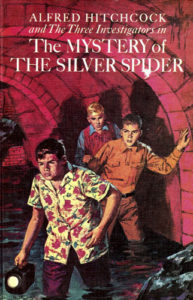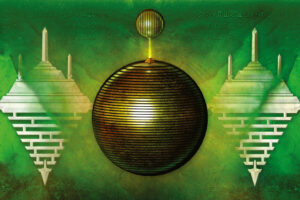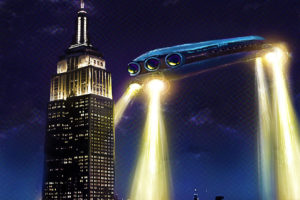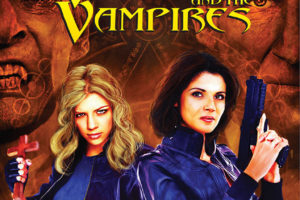 Probably the last hurrah for the classic juvenile book series was the Alfred Hitchcock and the Three Investigators series launched in 1964. Created for Random House by Robert Arthur Jr., the series ran for several years and has been kept in print until around 2003 or so.
Probably the last hurrah for the classic juvenile book series was the Alfred Hitchcock and the Three Investigators series launched in 1964. Created for Random House by Robert Arthur Jr., the series ran for several years and has been kept in print until around 2003 or so.
Robert Arthur Jr. actually started as a pulp writer in the 1930s and ’40s, with stuff published in many of the major pulp magazines including Amazing Stories, Argosy, Black Mask, Detective Story Magazine, and more. He later moved into scripting TV shows.
In the ’60s he edited several anthologies aimed at kids for Random House, all under Alfred Hitchcock’s name, such as Haunted Houseful, Ghostly Gallery, Monster Museum, and more. I had several of those as a kid, and they are probably still at my parents’ house. Alfred Hitchcock was probably the only movie director who I knew of as a kid, until people like George Lucas and Steven Spielberg came along.
So with that connection, Arthur probably thought a juvenile detective series that made use of Hitchcock’s name would sell. And it did. He himself wrote 10 of the first 11 books. He passed on in 1969, but had recruited others to carry on. Others authors of the series included Dennis Lynds, who wrote many works under a variety of names, including as Maxwell Grant for eight new paperbacks featuring The Shadow for Belmont in the 1960s.
So who are the Three Investigators? They are Jupiter Jones, Peter Crenshaw and Bob Andrews, all living in California near Hollywood. They formed their own detective agency. While their age was not given, they were about 13 or 14, as none were old enough to drive. During the first few books they had the use of a chauffeur and Rolls-Royce to drive them around, thanks to a contest one of them had won. (This was extended by a grateful client in an early book.) Otherwise they depended on bicycles or rides from parents to get where they needed to go.
Jupiter is the First Investigator, stocky and smart. Orphaned at a young age, he lives with his aunt and uncle. Pete is the Second Investigator, athletic so more the action man of the team. Bob is Records & Research, the studious type. In the first few books he was hampered by a leg brace due to multiple fractures.
A big part of the series was their headquarters. This seemed the ultimate kid’s secret club house! Jupiter’s uncle ran a salvage yard. In it, the team had taken an old house trailer for their headquarters, where they secured it toward the back and covered it up so it was hidden and won’t be bothered. They had setup several secret passages and entrances to it. There they had a private office, a lab, a dark room, and more. It even had a phone.
Like the original Scooby-Doo mysteries, the mysteries they dealt with started out as something strange going on, such as a whispering mummy or a talking skull, only to have them work out what was really going on.
Originally the series had a strong connection to Alfred Hitchcock himself. The idea was that the boys would come visit and tell him of their latest adventure, which became the source of the books. This introduced and then wrapped up the book, though he never wrote these (he did approve them). This lasted through #30, Secret of Shark Reef, in 1979. Hitchcock died in 1980, and the next volume, #31 in 1981, Hitchcock was replaced by fictitious mystery writer Hector Sebastian. Random House would soon reissue the earlier works with Hitchcock replaced by Sebastian. The series ended with #43 in 1987. A 44th volume was being worked on, but it’s unclear if it was completed or just outlined.
Interestingly, the series continued with new works in Germany, where the series was very popular. There was even two movies made there.
In the U.S., Random House revamped the series in 1989 with the 3 Investigators: Crime Busters, which now had the boys in high school (and driving). This one lasted 11 volumes. Apparently the series ended in 1990 due to disagreements with Robert Arthur Jr.’s heirs, who held some rights to the original series. Random House would later reprint the original series two more times with new covers.
I enjoyed this series as a kid. So much that I worked to get a complete set. At this point I have almost all the books, and am also trying to complete my set of original hardcover volumes (which ran until #28). While I’m usually not one for mysteries, these I really liked. The mysteries and characters I found much more interesting then the Hardy Boys.




Yeah, I also found The Three Investigators much more interesting and fun than The Hardy Boys. They were like the teenage versions of Jack, Doc and Reggie from “I Love A Mystery” Surprises me that there was never a Three Investigators movie or television series in this country.
I only read a few of the books when I was younger, but have rediscovered it as an adult after hearing people in the series book collecting community praise it. I finished the first two books, and I see why it is so popular. Interesting characters and good plots. I’m going to continue reading it. Whispering Mummy is not on the list!
The two movies from a German production company feature actors who speak in English. I find them to be pretty good, especially Terror Castle, though I know not everyone agrees with this.
The books in the series feature several author names. They are either the real name of the author or a personal pseudonym for the author.
My wife and I both had youth experiences with this and enjoy it still. Some volumes are better than others, of course.